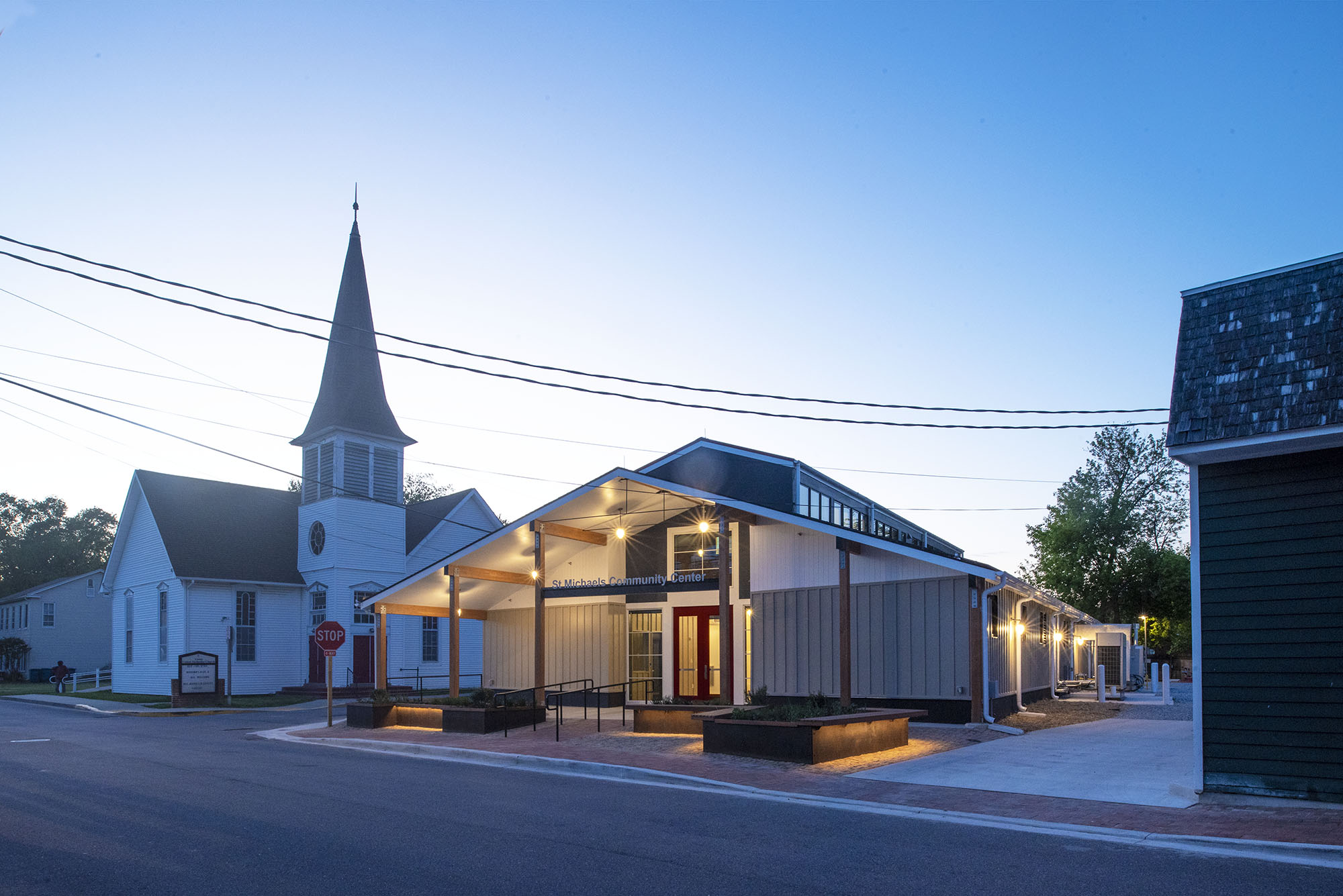- © 2026 Annapolis Home Magazine
- All Rights Reserved
St. Michaels Community Center
By Dylan Roche
Photography by Julia Heine

Blind Optimism. That’s a phrase architect Mark McInturff of McInturff Architects uses to describe the process of a big project like the St. Michaels Community Center—a project that was many years and millions of dollars in the making. Founded as an organization in 1990, the Center describes itself as “the heart of our community.” From a food pantry for neighbors in need to providing engaging activities for youth and seniors, the Center offers programs and services that seek to bring people together. They even hold seasonal community events such as Halloween parties and visits with Santa. But these kinds of activities need a facility, a home for everything the community center does.
Of course, establishing a home for a big, community-centered organization like this isn’t easy or inexpensive. “It’s a daunting project for a nonprofit, and it takes a lot of confidence and a belief in your ability to do it,” McInturff says. Hence, the idea of blind optimism. “You can’t look at each little difficult problem along the way—you have to say, ‘We can do this.’”
That’s not to say building a facility for the community center was done blindly. It had a full team of professionals, McInturff included, whose steady focus on the goal enabled them to ignore any doubts or cynicism. The goal? To turn what was once a lumberyard warehouse in the historic waterfront town into a home for the many programs and services the community center runs. The process began about a decade ago, when McInturff completed preliminary studies and made a model to show the community center’s board what they could do with the property. Then came the ‘dormant’ period marked by extensive planning and fundraising, followed by moving forward with blind optimism.
The project was ultimately a collaboration between McInturff and Easton-based Harper & Sons Contractors, directed by Benson Harper with project manager Ron Markey. Another influential contributor to the vision was Langley Shook, then the chairman of the community center’s board of directors. For everyone involved, McInturff says, it was a labor of love to turn the lumberyard warehouse into a functional facility for a thriving community-minded organization.
A self-described architectural history buff, McInturff recognized the value of the warehouse’s original timber frame. Consisting of aisles of columns that increase in height as they move toward the center, the timber frame, also known as a basilica, is used in various types of buildings. “All gothic churches are basilicas. St. Peter’s in Rome is a basilica, and so are many barns and Roman libraries,” he says. “It’s a versatile plan that you can plug anything into.”
Resolved not to interfere with an iconic style of architecture, he chose to keep the columns and beams. As there were no internal weight-bearing walls—just the columns and beams—it was easy to be flexible about the floor plan. The building’s main entrance lobby leads into the multipurpose room, which dominates the ground floor. McInturff specifically designed this space to accommodate a variety of event setups, such as tables for a dinner, seating for a lecture, or even staging for a performance—all without ever feeling cramped or stifled. “It’s big enough and ample enough and has a high enough ceiling,” he says. Sleek black metal and glass give the space a clean, modern look, while wood columns pay homage to the building’s tradition.
On one side of the multipurpose room is a set of classrooms with glass garage doors that can be opened or closed to divide the space as needed. On the other side is the facility’s commercial kitchen. The community center recognized the need for this important amenity not only to support events held there, but also to provide space for local restaurants and hotels to conduct workforce training.
A community center also needs office space, which McInturff could accommodate by adding a second story. “Because it’s in a historic district, we could not add one square inch to the building right on the footprint,” he explains. So, the only place to go was up. By putting the offices on the second floor, that space would serve the directors and the bookkeepers who aren’t necessarily involved in the day-to-day activities of the center. An added feature is that each office has a window that overlooks the multipurpose room.
With this modern building and the amenities it provides, the St. Michaels Community Center is now better poised to continue fulfilling its purpose—to serve, empower, and connect the people of St. Michaels. By turning a historic building into something beautiful and functional, McInturff—the one who had the vision for the facility from the very beginning—proves that what allows the St. Michaels community to thrive has been there all along, in one form or another. It’s just a matter of looking at it the right way.
ARCHITECTURE: Mark McInturff, McInturff Architects | BUILDER: Benson Harper and Ron Markey, Harper & Sons Contractors | ENGINEER: Lane Engineering
© Annapolis Home Magazine
Vol. 16, No. 4 2025